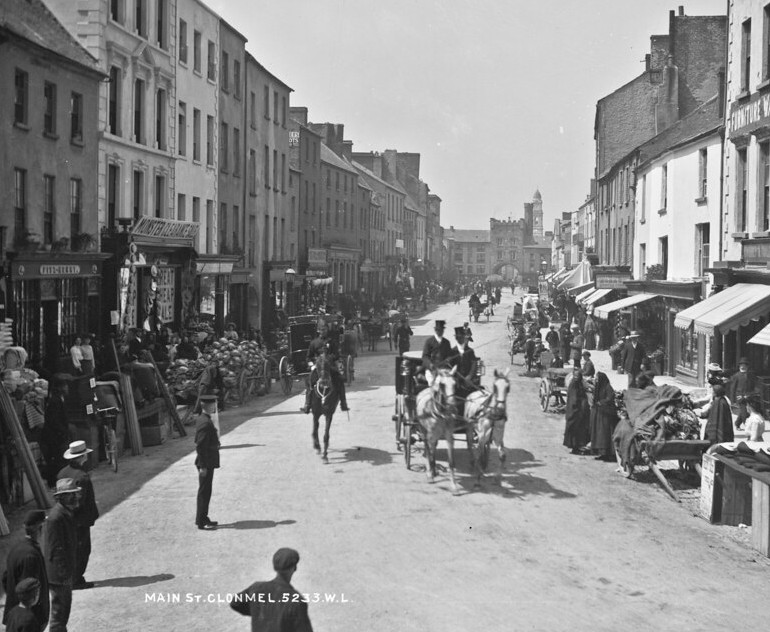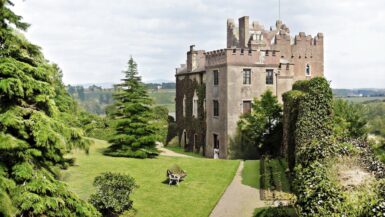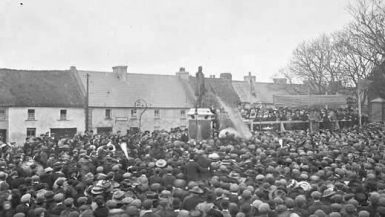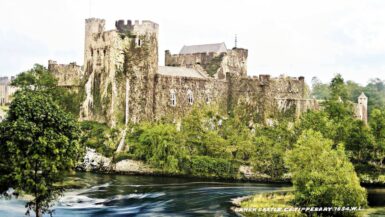CLONMEL, a borough, market, and assize town, a parish, and the head of a union, partly in the barony of Upperthird, county of Waterford, but chiefly in that of Iffa and Offa East, county of Tipperary, and
province of Minster, 23 miles (W. by N.) from Waterford, and 82 1/2 miles (S. W. by S.) from Dublin ; containing 17,720 inhabitants, of whom 13,505 are in the town. This place, whose origin is ascribed to a period prior to the invasion of the Danes, is supposed to have derived its name from Cluain-Meala, signifying in the Irish language the “plain of honey,” in allusion cither to the character of its situation and the peculiar richness of the soil, or to the circumstance of the valley in which it stands being bounded by picturesque mountains that afford honey of fine flavour. It appears to have been the capital of the palatine liberty, as it now is of the county, of Tipperary; and is probably indebted for its early importance to the
patronage of the Butler family. According to Archdall, a Dominican friary was founded here in 1269, but by
whom is not known – and the same author states that the Franciscan friary of Clonmel was also founded in
that year by Otho de Grandison, though the date inscribed upon it is 1265. This latter friary was reformed
in 1536, by the friars of the Strict Observance, and having been surrendered to the crown in 1540, was, with its possessions, three years after, granted in moieties to the sovereign and commonalty of Clonmel and the Earl of Ormonde, its church was esteemed one of the most magnificent ecclesiastical structures in the country. In 1516, the town, which was surrounded with walls and strongly fortified, was besieged and taken by the Earl of Kildare. During the civil war of the 17th century, having been garrisoned for the king by the Marquess of Ormonde, it was attacked by Cromwell in 1650, with his army from Kilkenny; but was bravely defended by Hugh O’Nial, a northern officer, who, with 1200 of his provincial forces, maintained it with such valour, that, in the first assault, not less than 2000 of the besieging army were slain, and the siege
was turned into a blockade. After a resolute defence for two months, the garrison, being without any prospect of obtaining relief, secretly withdrew to Waterford, and the inhabitants surrendered upon honourable terms: the town remained in the possession of the parliamentarians till a short time prior to the Restoration, when it was retaken by the royalists. At the Revolution, Clonmel was held by the partizans of James II., but was abandoned on the approach of William’s army to beseige Waterford.
The town is situated on the banks of the river Suir, in a beautiful and fertile valley bounded, as already observed, by picturesque mountains and on one of the two main roads from Dublin to Cork, and the road
from Waterford to Limerick. With the exception of that portion which is built on islands in the river, it is
wholly on the northern or Tipperary side of the Suir; it is connected with the county of Waterford by
bridges of stone. The principal street is spacious, and extends from east to west, under different names,
for more than a mile in a direction nearly parallel with the river; the total number of houses, in 1841, was 1660. The town is lighted with gas from works erected in 1824 by Messrs. Barton and Robinson, of Loodon,
who sold them, before they were completed, for about £8000 to the British Gas-Light Company of London,
under whom they are now held on lease. The provisions of the act of the 9th of George IV., for improving towns in Ireland, have been in operation, as regards lighting, watching, supplying water, and abating nuisances, since 1828: the inhabitants are amply supplied with water by public pumps in the various streets. A mechanics’ institute is supported: two newspapers are published ; and there are four news-rooms, one of which is a handsome building lately erected at the east end of the town, and called the County Club House. At the eastern entrance into the town are also extensive barracks for artillery, cavalry, and infantry behind them, on an elevated and healthy spot, is a small military hospital, capable of receiving 40 patients.
In 1667, the plan of Sir Peter Pett for introducing the woollen manufacture into Ireland was carried into
effect by the Duke of Ormonde, then lord-lieutenant; and, in order to provide a sufficient number of workmen, 500 families of the Walloons were invited over from Canterbury to settle here. The manufacture continued to flourish for some time, but at length fell into decay, in consequence of the prohibitory statutes passed by the English parliament soon after the Revolution, and it is at present nearly extinct. A factory for weaving cotton has been established by Mr. Malcomson, and affords employment to a large number of girls , he has also an extensive cotton-factory at Portlaw, some miles distant, in the county of Waterford. A very extensive trade is carried on in grain and other agricultural produce of the district, principally with the Liverpool and Manchester markets ; great quantities of bacon are also cured, and sent to London and the channel ports. There are two large ale and porter breweries in the town ; and at Marlfield, about a mile distant, is a distillery for whisky upon a very extensive scale. The only mineral production in the neighbourhood which forms an article of commerce is slate, of good quality, found at Glenpatrick and worked by the Irish Mining Company.
Though not a sea-port, the town, from its situation at the head of the Suir navigation, is the medium through which the corn and provision export trade is carried on between the southern and eastern portions of this large county and England. There are generally about 120 lighters, of from 20 to 50 tons” burthen, employed in the trade of this place; and several hundred carriers are engaged during winter on the roads communicating with Clonmel and the principal towns for 40 miles round : a considerable portion of the trade of Waterford also passes through the town. In a recent year, not less than 230,543 cwt. of flour,
28,678 barrels of wheat, 19,445 barrels of oats, 3878 barrels of barley, 21,559 cwt. of butter, 2769 cwt. of
lard, and 63,751 flitches of bacon, besides smaller quantities not enumerated, were sent for exportation. The navigation of the Suir was formerly very imperfect : in 1765, however, a parliamentary grant was obtained to form a towing-path, by which the passage of the boats was greatly accelerated. The river is still in many places so shallow that, in dry seasons, the navigaton is much impeded ; but an act has been obtained for its improvement , and it is proposed to form a railroad between Carrick, where a basin is intended to be formed, and Limerick, thereby opening a communication between the Suir and the Shannon. This railway will form part of the Waterford and Limerick line. There is a salmon-fishery in the river: the quays are spacious and commodious, extending from the central bridge along the north side. The Bank of Ireland, the Provincial Bank, and the National Bank, have branch establishments here ; and in Clonmel is the head office of the Tipperary Joint-Stock Bank, opened in 1842. The market days, under the charter of the 6th of James I., are Tuesday and Saturday, and fairs are held on May 5th and Nov. 5th . also on the first Wednesday in every month except May and November, for the sale of cattle, sheep, horses, and pigs, and on the preceding day for pigs only. The butter-market is a spacious building, provided with suitable offices for the inspector and others ; all butter, whether for home consumption or exportation, must be weighed and duly entered. There are also convenient shambles, and a large potato-market. In the excise arrangements the town gives name to, and is the head of, a district which comprises the towns of Cloghjordan, Nenagh, Templemore, Tipperary, Thurles, Cashel, Clonmel, and Carrick-on Suir. The royal mail and day car establishment, under the direction of its proprietor, Mr. Bianconi (to whose enterprising exertions the south of Ireland is indebted for the introduction of public cars), is in this town. A chief constabulary police station has been fixed here.
The corporation is of great antiquity, and probably exists by prescription. Numerous charters have at various times been granted since the reign of Edward I. ; that under which the borough was governed previously to the late change in its constitution, was granted in the 6th of James I. (1608), and after conferring the title of “The Mayor. Bailiffs, Free Burgesses, and Commonalty of the Town or Borough of Clonmel,” ordained that the corporation should consist of a mayor, two bailiffs, twenty free burgesses (including the mayor and bailiffs), and a commonalty, with a recorder, chamberlain, town-clerk, and other officers. The freedom was originally obtained by nomination of a burgess to the common council, a majority of whom decided on the admission , but latterly the rights of birth, extending, however, only to the eldest son, apprenticeship to a freeman within the borough, and marriage with a freeman’s daughter, were recognised as titles to it. By the two acts for the regulation of Municipal Corporations, 3rd and 4th, and 6th and 7th of Victoria, it was provided, that the borough should continue a ” town corporate,” divided into two wards, and should have six aldermen, and eighteen councillors ; the mayor to be elected out of the aldermen and councillors, on every 1st of December, and to enter upon office on the 1st of January following. The qualification of the mayor, aldermen, and councillors, is the possession of £1000 above debt, or a house worth £25 a year , and of the burgesses, to be each owner or tenant of a house, premises, or land within the borough, of £10 annual value after payment of all rates and taxes, and to be six months resident prior to election. The borough returned two member to the Irish Parliament till the Union, since which time it has sent one to the Imperial Parliament. The elective franchise was formerly vested in the freemen at large, amounting, in the year 1832, to 94 in number ; but by the act of the 2nd of William IV., cap. 88, it was extended to the £10 householders : the number of voters registered in 1843, was 637, of whom 586 were £10 householders, and 51 freemen ; the mayor is the returning officer. The electorial boundary, under the act of the 2nd of William IV., cap. 89, is confined to the town, including Long Island on the south, and a space on the north side of the river fur buildings contemplated in that quarter; it comprises an area of 361 statute acres. The jurisdiction of the corporation extends over a large rural district comprising about 4800 statute acres, of which 3800 are in the county of Waterford, and 1000 in Tipperary : the mayor and recorder, under the old regime, were justices of the peace. The late tholsel court, for determining pleas to any amount within the town and liberties, in which either the cause of action arose or the defendant resided, was held every Wednesday, before the mayor and bailiff’s. The mayor’s court, in which he presides, is held every Wednesday, for the recovery of debts not exceeding 10s. late currency ; and the mayor and bailiff’s used to hold a court leet twice in the year. Petty- sessions are held every alternate Friday. The elections of parliamentary representatives, and the assizes and quarter- sessions, for the county of Tipperary, are held here ; the quarter-sessions in April and October. The old court-house, built after a design by Sir Christopher Wren, was some years since converted into shops , the new court-house is a light and handsome structure. The county gaol is a large stone building ; but prior to the erection of the house of correction, which was completed in the year 1834, it was too small for the number of prisoners generally confined in it : it is now well adapted to their classification, and contains schools for both sexes, and a tread-mill, which is applied to the raising of water for the supply of the prison.
The parish, called St. Mary’s, extends beyond the Suir a considerable distance into the county of Waterford, and comprises 10,388 statute acres. The principal seats are, Knocklofty, that of the Earl of Donoughmore; Kilmanahan Castle; Marlfield, of the Bagwell family; Barn, of the Moore family; Woodrooff; Rathronan, of General Sir H. Gough, G. C. B., elevated to the peerage as Baron Gough in April, 1846, in acknowledgment of his late splendid services and many and signal victories in China and in India ; Kiltinane Castle ;
Darling Hill, of the Hon. Baron Pennefather; and Newtown- Anner : there are many other handsome residences. The views from the demesnes of Knock-lofty and Kilmanahan Castle abound with interest and
variety, and are not surpassed by any in this part of the country. At Kiltinane Castle, a very rapid stream
issuing from a rock forms a remarkable natural curiosity. The living is an entire rectory, in the diocese
of Lismore, and till lately in the gift of the Corporation: the tithe rent-charge is £225. The glebe-house was
built by aid of a gift of £100 and a loan of £650 from the Board of First Fruits, in 1810 ; the glebe, dispersed
in small parcels in the town and suburbs, comprises 3 1/4 acres. The church, dedicated to St. Mary, is an ancient structure, with a handsome octangular embattled tower, 84 feet high, at the eastern extremity of the south side; it was formerly a good specimen of the early English style of architecture, but on its repair, in 1805, it was modernised, and the building now retains but little of its original character. A grant of £1019. 12. was more recently made by the Ecclesiastical Commissioners for its repair. In the chancel is a beautiful monument, by Taylor, of York, to the memory of Mary, wife of J. Bagwell, Esq., and recording likewise the death of that gentleman and his eldest son, the late Right Hon. William Bagwell. There is also a monument erected by the parishioners, in the year 1795, as a tribute of respect to the memory of Dr. J. Moore, who was rector for 66 years. In the porch are slabs with inscriptions and armorial bearings of the noble family of Hutchinson, lords Donoughmore, and in one of the shields are impaled the arms of Moore, of Barn. The Roman Catholic parish is co-extensive with that of the Established Church, and is the benefice of the vicar-general of the united dioceses of Waterford and Lismore : it contains two chapels, one in Irishtown, and the other, a, large and neat modern building, in Johnston-street ; also a Franciscan friary in Warren-street, lately rebuilt, and a Presentation convent situated beyond the western bridge. There are places of worship for Presbyterians in connexion with the Synod of Munster, for the Society of Friends, Baptists, Unitarians, and Primitive and Wesleyan Methodists.
The grammar school was founded in 1685, by R. and S. Moore, Esqrs., ancestors of the Mountcashcll family,
who endowed it with the lands of Lissenure and Cloubough in the county of Tipperary, producing a rental of £369, for the gratuitous instruction of the sons of freemen in Latin. The old school-house having fallen into decay, a large and substantial building has been erected witbin the last few years at the western extremity of the town, on a site granted at a nominal rent by the late Col. Bagwell 1 the cost was nearly £5000, whereof £4000 were advanced out of the consolidated fund, for the repayment of which, £240 per annum are appropriated from the proceeds of the endowment. A parochial school for boys is partly supported by a joint bequest from Dr. Ladyman and Mrs. Pomeroy, amounting to £7 per annum late currency, and by £2 per annum from the rector ; there are also a parochial school for girls and an infants’ school, both supported by voluntary contributions. A handsome building has been erected for these schools, containing three rooms, each capable of accommodating 100 scholars. A school for boys is supported by collections at the Roman Catholic chapels, which are partly appropriated in paying the master’s salary, and partly in providing clothing for the children ; and, among other schools, are Sunday schools in connexion with the Established Church and the Presbyterian and Methodists’ congregations.
The fever hospital, and the dispensary adjacent to it, both commodious buildings on the north side of the
town, are liberally supported. The house of industry for the county of Tipperary, for the reception and
support of 50 male and 50 female aged and infirm poor persons of good character, and for the restraint of male and female vagrants, is an extensive building in an airy situation at the foot of the western bridge, opened in 1811. It is supported by grand jury presentments, and is under the government of a corporation by act of parliament ; it has a department for orphan children, who, when of proper age, are apprenticed to different trades. The receipts in a recent year were £1543. 5., and the expenditure, £1335. 16. A district lunatic asylum for the county was opened in 1835 : the building is capable of accommodating 60 patients, and was erected at an expense, including the purchase of land, furniture, &c, of £16,588. From its opening, to the 31st March, 1841, 339 patients were admitted, of whom 159 recovered, 23 were discharged relieved, 46 died, and 28 were relapsed cases ; leaving in the asylum 111. The expenditure in 1844 was £2087. A savings’ bank has been opened ; and there are a mendicity society and a clothing society, the latter established in 1833. A society has likewise been formed for the maintenance and education of the orphan children of Protestant parents, and within the first year, 33 were so provided for. Charitable bequests to a considerable amount have been left to the parish by different individuals. The union workhouse was completed in 1840, and is constructed to receive 600 paupers.
Of the town walls, which encompassed what is now the central part of the town, on the northern bank of the river, there are still some slight remains. The entrance was by four principal gates : of these, the west gate, which has been very substantially repaired and forms an ornament to the town, is now standing ; and of the various towers by which the walls were defended, three remain near the churchyard. Near the western end of the town are the ruins of the church of St. Stephen, and in the southern suburb those of the church of St. Nicholas. Some trifling remains of the ancient castle may still be traced in what is now the office of the Tipperary Free Press. In the neighbourhood are the ruins of several castles, and traces of encampments or Danish forts ; at Gurteen is a cairn or Druids’ altar ; and near Oakland is a holy well, called St. Patrick’s well , also the ruins of an ancient chapel, in which are several large stones bearing inscriptions. About half a mile to the south-east is a chalybeate spring, resorted to for medicinal purposes ; and near the south suburb is another of a similar kind, but not much used. Laurence Sterne was born here in 1713 ; and Bonaventura Baro, or Baron, who wrote numerous works during a long residence at Rome, where he died, was also born here. Clonmel gives the titles of Earl and Viscount to the family of Scott ; the grand-father of the present earl was the Right Hon. John Scott, the celebrated chief justice of the King’s Bench in Ireland, who was created Baron Earlsfort in 1784, and advanced to the Viscounty of Clonmel in 1789. and to the Earldom in 1793.
Extract from: Lewis – A Topographical Dictionary of Ireland
Photo from: The Lawrence Collection






Leave a reply